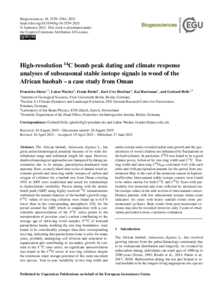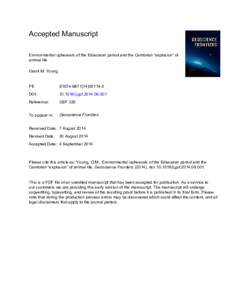Document
High-resolution 14C bomb peak dating and climate response analyses of subseasonal stable isotope signals in wood of the African baobab : a case study from Oman.
Identifier
DOI: 10.5194/bg-18-3539-2021
Source
Biogeosciences. v. 18, 12, p. 3539-3564
Contributors
Wacker, Lukas., Author
Riedel, Frank., Author
Heußner, Karl-Uwe., Author
Hartmann, Kai., Author
Helle, Gerhard., Author
Country
Germany.
Publisher
Copernicus GmbH.
Gregorian
2021-07-17
Language
English
English abstract
The African baobab, Adansonia digitata L., has great paleoclimatological potential because of its wide distributional range and millennial length life span. However, dendroclimatological approaches are hampered by dating uncertainties due to its unique, parenchyma-dominated stem anatomy. Here, securely dated time series of annual wood increment growth and intra-ring stable isotopes of carbon and oxygen of cellulose for a baobab tree from Oman covering 1941 to 2005 were established and tested for relationships to hydroclimate variability. Precise dating with the atomic bomb peak (ABP) using highly resolved 14C measurements confirmed the annual character of the baobab's growth rings. F14C values of tree-ring cellulose were found up to 8.8 lower than in the corresponding atmospheric CO2 for the period around the ABP, which in conjunction with a considerable autocorrelation of the ?13C series points to the incorporation of previous year's carbon contributing to the average age of intra-ring wood samples. F14C of terminal parenchyma bands, marking the tree-ring boundaries, were found to be considerably younger than their corresponding tree ring, indicating that parenchyma tissue is alive for many years, probably undergoing cell division and structural reorganization and contributing to secondary growth. In contrast to the ?13C time series, no significant autocorrelation was found in the ?18O series of tree-ring cellulose despite the enormous water storage potential of this stem-succulent tree species. Year-to-year variability in tree-ring width and stable isotope ratios revealed radial stem growth and the geochemistry of wood cellulose are influenced by fluctuations in the hydroclimate. In particular, ?18O was found to be a good climate proxy, followed by tree-ring width and ?13C. Tree-ring width and intra-ring ?18Omin correlated well with each other and with precipitation amount for the period from pre-monsoon May to the end of the monsoon season in September/October. Intra-annual stable isotope courses were found to be rather similar for both ?13C and ?18O. Years with particularly low monsoon rain were reflected by increased stable isotope values in the mid-section of intra-annual courses. Distinct patterns with low subseasonal isotope values seem indicative for years with heavy rainfall events from pre-monsoonal cyclones. Rain events from post-monsoonal cyclones may also be recorded; however, only 2 years of observation prevented a more conclusive evaluation.
ISSN
1726-4170
Resource URL
Category
Journal articles


